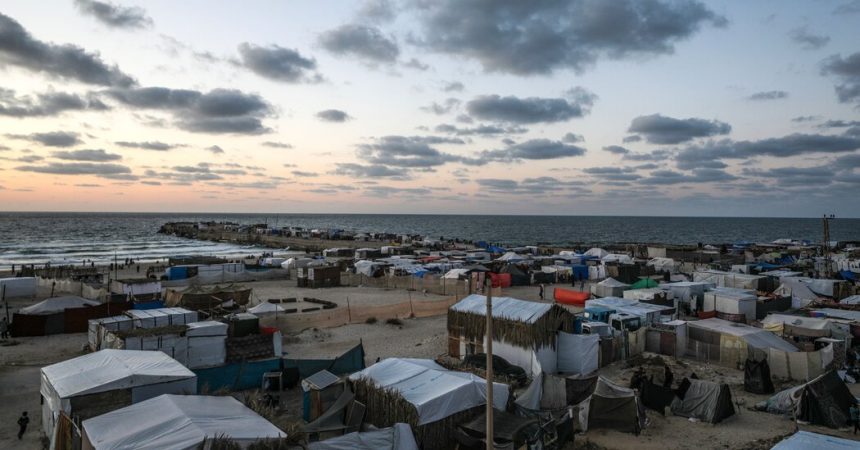Israel said on Thursday that it would send more troops to Rafah, the southernmost city in Gaza, which has become the focal point in the war between Israel and Hamas.
The announcement signaled that Israel intends to press deeper into Rafah despite international concerns about the threat to civilians from a full-scale invasion of the city, where more than a million displaced people had been sheltering.
“Hundreds of targets have already been attacked,” Yoav Gallant, Israel’s defense minister, said after meeting with commanders in the Rafah area. “This operation will continue.”
For the past week Israel has described its offensive as a limited military operation, but satellite imagery and Mr. Gallant’s comments on Thursday suggested that a more significant incursion was already underway.
Rafah is the most important logistics hub in the Gaza Strip, the crucial gateway for most of the food, medicine and other aid that has entered the enclave of 2.2 million people. The fighting has led to the closure of a border crossing between Rafah and Egypt and, for a time, greatly reduced traffic at one between Rafah and Israel at Kerem Shalom.
“The threat of famine in Gaza never loomed larger,” the United Nations’ World Food Program warned this week.
As Israel pushes more deeply into Rafah, and renewed Israeli airstrikes and fighting in hard-pressed northern Gaza send tens of thousands of other civilians fleeing, the questions of where displaced Gazans will go and how food, medicine and other essentials will enter and be distributed across Gaza are growing more critical.
Ra’fat Abu Tueima, 62, and his family have been forced to move six times since the start of the war in Gaza. On Thursday he found himself in his latest makeshift shelter, crammed inside a tent in the battle-ravaged city of Khan Younis wondering how he will feed his nine children.
A taxi driver before the war, Mr. Abu Tueima is among what the United Nations estimates is an exodus of 600,000 people from the southern city of Rafah and its surroundings, where Israeli airstrikes are pounding the land and tanks are rumbling ever deeper into the urban sprawl.
Mr. Abu Tueima, his tent erected in a school courtyard, said he felt abandoned. “No one here helped us with anything,” he said, the stress of seven months of war bringing him to tears.
In Rafah, which he fled last week, he was able to find some aid, Mr. Abu Tueima said. But in Khan Younis he feels bereft of hope. “Not one single person asked about us,” he said. “No one even cares about all of those children and women here.”
Outside the school courtyard on Thursday, a few trucks carrying humanitarian aid drove down the street. Children tried to grab whatever they could, a few making off with bags of sugar.
As criticism of Israel’s military operations mounted on Thursday, South Africa urged the judges of the International Court of Justice to order an end to the ground assault on Rafah, saying it put Palestinian life in the enclave at imminent risk of destruction.
The hearing came after South Africa requested last week that the court issue further constraints on Israel’s military campaign in Gaza. In filings disclosed by the court, South Africa cited the “irreparable harm” posed by Israel’s incursion into Rafah.
“It has become increasingly clear that Israel’s actions in Rafah are part of the end game in which Gaza is utterly destroyed as an area capable of human habitation,” Vaughan Lowe, a British lawyer, told the court. “This is the last step in the destruction of Gaza and its Palestinian people.”
Israel, which denies the claim of genocide, says its latest assault on eastern Rafah is a “precise operation” targeting members of Hamas. It is expected to make its defense before the court on Friday.
In one hopeful development, the American military anchored a temporary pier on Gaza’s coast on Thursday, creating an additional point of entry for humanitarian aid, though the system is still being tested.
Aid will be loaded onto trucks that will begin moving ashore “in the coming days,” the U.S. Central Command said in a statement Thursday morning. Officials said last week that the floating pier and causeway had been completed, but that weather conditions had delayed their installation.
An American ship loaded with humanitarian aid, the Sagamore, set off last week from Cyprus for Gaza, where the materials were loaded onto a smaller vessel for transport to the pier. The United Nations will receive the shipment and oversee its distribution in Gaza, according to Central Command, which said no American troops would set foot in the territory.
Over the next two days, the U.S. military and humanitarian groups will aim to load three to five trucks from the pier and send them into Gaza as a trial run, said Gen. Charles Q. Brown, the chairman of the Joint Chiefs of Staff.
“It’ll probably take another 24 hours to make sure everything is set up,” General Brown told reporters on Thursday aboard a flight to Brussels, where he was attending a NATO meeting. “We have our force protection that’s been put in place, we have contract truck drivers on the other side, and there’s fuel for those truck drivers as well.”
The Pentagon hopes the pier operation will bring in enough aid for around 90 trucks a day initially, reaching 150 a day when it reaches full capacity, officials say.
Aid agencies and U.N. officials have said the Gaza Strip requires around 500 to 600 trucks a day at minimum to meet its needs.
In a briefing on Thursday, an Israeli military spokesman, Lt. Col. Nadav Shoshani, said supporting the temporary pier project was a “top priority.” He said the Israeli Navy and the 99th Division were supporting the effort by sea and by land.
In Rafah, the Israeli military has until this point described its operations as a limited incursion. Both the United States and the European Union have warned against a major invasion there, saying that the humanitarian toll would be too high.
Satellite imagery captured on Wednesday showed Israeli forces pushing closer to the center of Rafah. Collapsed buildings and debris can be seen throughout the eastern parts of the city, a contrast to images from last week, when only limited damage was visible.
Many areas of Rafah that were full of tents and vehicles just a week ago appeared empty on Wednesday.
Reporting was contributed by Victoria Kim, Natan Odenheimer, Lauren Leatherby, Rawan Sheikh Ahmad, Helene Cooper, Gaya Gupta, Matthew Mpoke Bigg, Marlise Simons and Johnatan Reiss.







